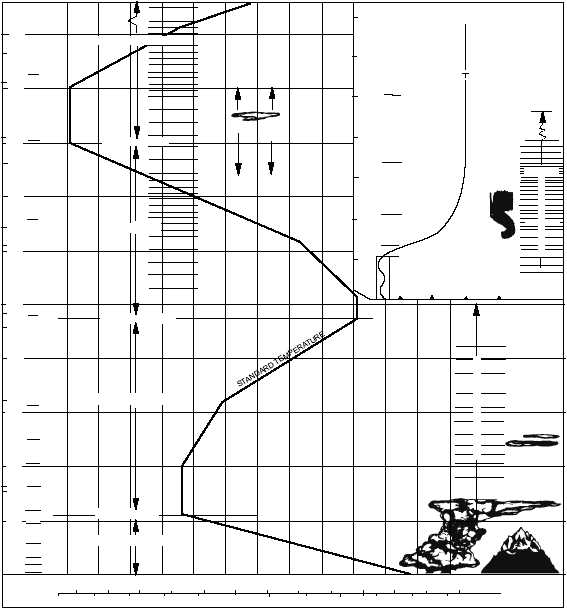subtract 32 from the Fahrenheit and divide the
remainder by 1.8.
Examples:
1.
F = l.8C + 32
Given: 24°C. Find: °F
24 × 1.8 = 43.2
43.2 + 32 = 75.2 or 75°F.
2.
C =
F
32
1.8
-
Given: 96°F. Find: °C.
96 – 32 = 64
64 + 1.8 = 35.5 or 36°C
To change a Celsius reading to an absolute value,
add the Celsius reading to 273° algebraically. For
example, to find the absolute value of -35°C, you would
add minus 35° to 273°K algebraically. That is, you take
273° and combine 35° so you use the minus (-) function
to arrive at 238°K.
To change a Fahrenheit reading to an absolute
value, first convert the Fahrenheit reading to its
equivalent Celsius value. Add this value algebraically
to 273°. Consequently, 50°F is equivalent to 2830
absolute, arrived at by converting 50°F to 10°C and
then adding the Celsius value algebraically to 273°.
VERTICAL DISTRIBUTION
Earth’s atmosphere is divided into layers or zones
according to various distinguishing features. (See fig.
1-9). The temperatures shown here are generally based
on the latest “U.S. Extension to the ICAO Standard
1-15
AURORA
TEMPERATURE
(KINETIC)
PRESSURE
(MB)
NOCTILUCENT
CLOUDS
0
500
1000
1500
2000
600
500
400
300
200
100
700
2500
10
10
10
10
10
TROPOPAUSE
NACREOUS
CLOUDS
MT EVEREST
180
190
200
210
220
230
240
250
260
270
280
290
300 DEGREES K
DEGREES C
DEGREES F
100
200
300
500
700
850
1000
50
50
25
10
100
150
200
10
-1
1
250
10-2
-3
300
GEOMETRIC
HEIGHT
F REGION
E REGION
D REGION
10
KILOMETERS
100
90
60
80
70
40
50
10
20
30
STRATOSPHERE
STRATOPAUSE
MESOPAUSE
THERMOSHPERE
MESOSPHERE
TROPOSPHERE
GEOMETRIC HEIGHT
KILOMETERS
(400) MILES
(300)
(200)
(100)
-4
-5
-6
-7
-8
(MILES)
(60)
PRESSURE
(MB)
TEMPERATURE
(10)
(20)
(30)
(40)
(50)
THOUS
OF FEET
-90
-140
-120
-100
-80
-70
-80
-60
-50
-60
-40
-40
-30
-20
-20
0
-10
20
0
32
40
10
60
20
80
30
O
Z
O
N
O
S
P
H
E
R
E
E REGION
D REGION
DEG. K
I
O
N
O
S
P
H
E
R
E
F
REGION
2
F
REGION
1
AGf0109
Figure 1-9.—Earth's Atmosphere.


